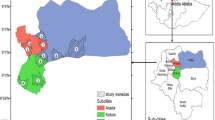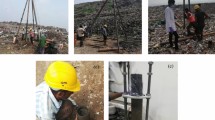Abstract
The present study assesses the reuse potential of landfill mining waste, finer than 2 mm retrieved from the urban mining activity at Ariyamangalam dumpsite located at Tamil Nadu, India. The reuse potential was evaluated for earthfill by auditing the crucial parameters such as the intensity of colored leachate, heavy metal concentration, soluble salts, and organic content. In addition, geotechnical characteristics were examined for their potential usage at offsite applications. On the other hand, reuse potential as compost was analyzed by the presence of nutrient levels, including total organic carbon, total nitrogen, total phosphorus, total potassium, and heavy metal concentration. Based on the assessment results, the reuse potential of soil-like material at earthworks, ridges, closure, and dumping of mines and trenches, and usage in bulk demands safety design measures have been discussed. The necessity of treatment before offsite applications is critically analyzed because of its enormous amount of heavy metals, organic content, and soluble salt concentration. The reuse potential as compost material could be restricted to non-agricultural application and barren land reclamation considering its high heavy metal concentration. Apart from providing additives fulfilling 12% of total organic carbon, it poses other desirable nutrient levels such as 0.8% total nitrogen, 0.4% total phosphorus, and 0.4% total potassium for compost material.









Similar content being viewed by others
Data availability
Not applicable.
Code availability
Not applicable.
References
Adeniyi LA, Afon AO (2022) Seasonal quantification and characterization of solid waste generation in tertiary institution: a case study. J Mater Cycles Waste Manage. https://doi.org/10.1007/s10163-022-01390-0
Boonsakul P, Buddhawong S, Towprayoon S et al (2021) Applying electromagnetic surveys as pre-screening tools prior to open dump mining. J Mater Cycles Waste Manage 23:1518–1530. https://doi.org/10.1007/s10163-021-01232-5
Hogland W, Marques M, Nimmermark S (2004) Landfill mining and waste characterization: a strategy for remediation of contaminated areas. J Mater Cycles Waste Manage. https://doi.org/10.1007/s10163-003-0110-x
Tyagi VK, Fdez-Güelfo LA, Zhou Y et al (2018) Anaerobic co-digestion of organic fraction of municipal solid waste (OFMSW): progress and challenges. Renew Sustain Energy Rev 93:380–399. https://doi.org/10.1016/j.rser.2018.05.051
CPCB (2019) CPCB Notice-Dumpsite Ban
Devahi P, Deendayal R, Muthukkumaran K (2022) Building material synthesization using municipal solid waste incineration ash: a state-of-the-art review. Environ Technol Rev 11:33–48. https://doi.org/10.1080/21622515.2021.2024890
O’Connor OA, Dewan R, Galuzzi P, Young LY (1990) Landfill leachate: a study of its anaerobic mineralization and toxicity to methanogenesis. Arch Environ Contam Toxicol 19:143–147. https://doi.org/10.1007/BF01059823
Plotkin S, Ram NM (1984) Multiple bioassays to assess the toxicity of a sanitary landfill leachate. Arch Environ Contam Toxicol 13:197–206. https://doi.org/10.1007/BF01055877
Liu H, Wang Y, Dong J et al (2021) Distribution characteristics, pollution assessment, and source identification of heavy metals in soils around a landfill-farmland multisource hybrid district. Arch Environ Contam Toxicol 81:77–90. https://doi.org/10.1007/s00244-021-00857-9
Zhou C, Xu W, Gong Z et al (2015) Characteristics and fertilizer effects of soil-like materials from landfill mining. Clean: Soil, Air, Water. https://doi.org/10.1002/clen.201400510
Kaczala F, Mehdinejad MH, Lääne A et al (2017) Leaching characteristics of the fine fraction from an excavated landfill: physico-chemical characterization. J Mater Cycles Waste Manage 19:294–304. https://doi.org/10.1007/s10163-015-0418-3
Xiong Y, Takaoka M, Kusakabe T et al (2020) Mass balance of heavy metals in a non-operational incinerator residue landfill site in Japan. J Mater Cycles Waste Manage 22:354–364. https://doi.org/10.1007/s10163-020-00976-w
Li Y, Cen H, Chiu Y, ho, Lin TY, (2021) Waste landfill plant and waste disposal plant efficiencies in China. J Mater Cycles Waste Manage 23:922–936. https://doi.org/10.1007/s10163-021-01178-8
Mönkäre TJ, Palmroth MRT, Rintala JA (2016) Characterization of fine fraction mined from two Finnish landfills. Waste Manage 47:34–39. https://doi.org/10.1016/j.wasman.2015.02.034
Wanka S, Münnich K, Fricke K (2017) Landfill Mining - Wet mechanical treatment of fine MSW with a wet jigger. Waste Manage 59:316–323. https://doi.org/10.1016/j.wasman.2016.10.050
Masi S, Caniani D, Grieco E et al (2014) Assessment of the possible reuse of MSW coming from landfill mining of old open dumpsites. Waste Manage 34:702–710. https://doi.org/10.1016/j.wasman.2013.12.013
Quaghebeur M, Laenen B, Geysen D et al (2013) Characterization of landfilled materials: Screening of the enhanced landfill mining potential. J Clean Prod 55:72–83. https://doi.org/10.1016/j.jclepro.2012.06.012
Hanson JL, Yeşiller N, Onnen MT et al (2013) Development of numerical model for predicting heat generation and temperatures in MSW landfills. Waste Manage 33:1993–2000. https://doi.org/10.1016/j.wasman.2013.04.003
Scheu M, Bhattacharyya JK (1997) Reuse of decomposed waste. Lessons from India in solid waste management, Department of International Development, UK Government
Prechthai T, Padmasri M, Visvanathan C (2008) Quality assessment of mined MSW from an open dumpsite for recycling potential. Resour Conserv Recycl 53:70–78. https://doi.org/10.1016/j.resconrec.2008.09.002
Mukhopadhyay S, Masto RE, Cerdà A, Ram LC (2016) Rhizosphere soil indicators for carbon sequestration in a reclaimed coal mine spoil. CATENA 141:100–108. https://doi.org/10.1016/j.catena.2016.02.023
Indian Standards B IS 2720–4 (1985): Methods of test for soils, Part 4: Grain size analysis
Kaartinen T, Sormunen K, Rintala J (2013) Case study on sampling, processing and characterization of landfilled municipal solid waste in the view of landfill mining. J Clean Prod 55:56–66. https://doi.org/10.1016/j.jclepro.2013.02.036
Kurian J, Esakku S, Palanivelu K, Selvam A (2003) Studies on landfill mining at solid waste dumpsites in India. Ninth Int Waste Manag Landfill Symp 3:6–10
Jani Y, Pehme K, Bucinskas A et al (2018) Speciation of Cu, Zn and Cr in excavated fine fraction of waste at two landfills. Iran J Energy Environ 9:86–90. https://doi.org/10.5829/ijee.2018.09.02.02
Somani M, Datta M, Ramana G, v., Sreekrishnan TR, (2018) Investigations on fine fraction of aged municipal solid waste recovered through landfill mining: Case study of three dumpsites from India. Waste Manage Res 36:744–755. https://doi.org/10.1177/0734242X18782393
Iglesias Jim E, Garcia rez, (1992) Relationships between organic carbon and total organic matter in municipal solid wastes and city refuse composts. Bioresour Technol 41:265–272
No.11–3/83-STU Government of India Ministry of Agriculture AND Rural Development (department of agriculture and cooperation)
Somani M, Datta M, Gupta SK et al (2019) Comprehensive assessment of the leachate quality and its pollution potential from six municipal waste dumpsites of India. Bioresour Technol Rep 6:198–206. https://doi.org/10.1016/j.biteb.2019.03.003
Somani M, Datta M, Ramana G, v., Sreekrishnan TR, (2020) Contaminants in soil-like material recovered by landfill mining from five old dumps in India. Process Saf Environ Prot 137:82–92. https://doi.org/10.1016/j.psep.2020.02.010
Hull RM, Krogmann U, Strom PF (2005) Composition and characteristics of excavated materials from a new jersey landfill. J Environ Eng 131:478–490. https://doi.org/10.1061/(asce)0733-9372(2005)131:3(478)
Singh A, Chandel MK (2020) Effect of ageing on waste characteristics excavated from an Indian dumpsite and its potential valorisation. Process Saf Environ Prot 134:24–35. https://doi.org/10.1016/j.psep.2019.11.025
Hogland W, Marques M, Nimmermark S (2004) Landfill mining and waste characterization: a strategy for remediation of contaminated areas. J Mater Cycles Waste Manage 6:119–124. https://doi.org/10.1007/s10163-003-0110-x
Bozkurt S, Moreno L, Neretnieks I (1999) Long-term fate of organics in waste deposits and its effect on metal release. Sci Total Environ 228:135–152. https://doi.org/10.1016/S0048-9697(99)00047-9
(2005) Guidelines for modification and stabilization of soils and base for use in pavement structures
Burlakovs J, Kaczala F, Vincevica-Gaile Z et al (2016) Mobility of metals and valorization of sorted fine fraction of waste after landfill excavation. Waste Biomass Valoriz 7:593–602. https://doi.org/10.1007/s12649-016-9478-4
Karim MdR, Kuraoka M, Higuchi T et al (2017) Assessment of heavy metal contamination from municipal solid waste open dumping sites in Bangladesh. Int J Environ Waste Manage 19:191–202. https://doi.org/10.1504/IJEWM.2017.084297
Jain P, Kim H, Townsend TG (2005) Heavy metal content in soil reclaimed from a municipal solid waste landfill. Waste Manage 25:25–35. https://doi.org/10.1016/j.wasman.2004.08.009
Xiaoli C, Shimaoka T, Xianyan C et al (2007) Characteristics and mobility of heavy metals in an MSW landfill: implications in risk assessment and reclamation. J Hazard Mater 144:485–491. https://doi.org/10.1016/j.jhazmat.2006.10.056
Rong L, Zhang C, Jin D, Dai Z (2017) Assessment of the potential utilization of municipal solid waste from a closed irregular landfill. J Clean Prod 142:413–419. https://doi.org/10.1016/j.jclepro.2015.10.050
Hölzle I (2019) Contaminant patterns in soils from landfill mining. Waste Manage 83:151–160. https://doi.org/10.1016/j.wasman.2018.11.013
Flemish soil remediation and protection regulations
(99AD) Soil requirements for landscaping use
SWM 2016. Solid waste management rules
William Brinton by F, Manager P (2000) COMPOST QUALITY STANDARDS & GUIDELINES Final Report New York State Association of Recyclers
Jani Y, Kaczala F, Marchand C et al (2016) Characterisation of excavated fine fraction and waste composition from a Swedish landfill. Waste Manage Res 34:1292–1299. https://doi.org/10.1177/0734242X16670000
Anake WU, Adie GU, Osibanjo O (2009) Heavy metals pollution at municipal solid waste dumpsites in Kano and Kaduna states in Nigeria. Bull Chem Soc Ethiop 23:281–289. https://doi.org/10.4314/bcse.v23i2.44972
Song YS, Yun JM, Hong WP, Kim TH (2003) Investigation of solid waste soil as road construction material. Environ Geol 44:203–209. https://doi.org/10.1007/s00254-002-0746-1
Okonta F, Tchane F (2017) Shear strength of municipal solid waste. ICSMGE 2017-19th International Conference on Soil Mechanics and Geotechnical Engineering 135:467–470. https://doi.org/10.1061/(asce)gt.1943-5606.0000063
Zekkos D, Kabalan M, Syal SM et al (2013) Geotechnical characterization of a municipal solid waste incineration ash from a Michigan monofill. Waste Manage 33(1442):1450. https://doi.org/10.1016/j.wasman.2013.02.009
Zhong Z, Chen Z, Xu Y et al (2018) Relationship between soil organic carbon stocks and clay content under different climatic conditions in Central China. Forests. https://doi.org/10.3390/f9100598
Giardina CP, Ryan MG, Hubbard RM, Binkley D (2001) Tree species and soil textural controls on carbon and nitrogen mineralization rates. Soil Sci Soc Am J 65:1272–1279. https://doi.org/10.2136/sssaj2001.6541272x
Fatahi B, Khabbaz H, Fatahi B (2015) Chapter 8-improving geotechnical properties of closed landfills for redevelopment using chemical stabilization techniques: a case study on samples of a landfill site in southwest of sydney. In: Indraratna B, Chu J, Rujikiatkamjorn C (eds) Ground improvement case histories. Butterworth-Heinemann, pp 239–266
Oettle NK, Matasovic N, Kavazanjian E, Rad N (2010) characterization and placement of municipal solid waste as engineered fill. ResearchgateNet 1–10
Saha JK, Panwar N, Singh M, v. (2010) An assessment of municipal solid waste compost quality produced in different cities of India in the perspective of developing quality control indices. Waste Manage 30:192–201. https://doi.org/10.1016/j.wasman.2009.09.041
Author information
Authors and Affiliations
Corresponding author
Ethics declarations
Conflict of interest
We declare that this manuscript is original, has not been published before and is not currently being considered for publication elsewhere. If accepted, it will not be published elsewhere. We know of no conflicts of interest associated with this publication.
Additional information
Publisher's Note
Springer Nature remains neutral with regard to jurisdictional claims in published maps and institutional affiliations.
Rights and permissions
Springer Nature or its licensor (e.g. a society or other partner) holds exclusive rights to this article under a publishing agreement with the author(s) or other rightsholder(s); author self-archiving of the accepted manuscript version of this article is solely governed by the terms of such publishing agreement and applicable law.
About this article
Cite this article
P, D., Rathod, D. & Muthukkumaran, K. Sustainable reuse potential of landfill mining waste retrieved from urban mining sites in South India. J Mater Cycles Waste Manag 24, 2582–2597 (2022). https://doi.org/10.1007/s10163-022-01506-6
Received:
Accepted:
Published:
Issue Date:
DOI: https://doi.org/10.1007/s10163-022-01506-6




